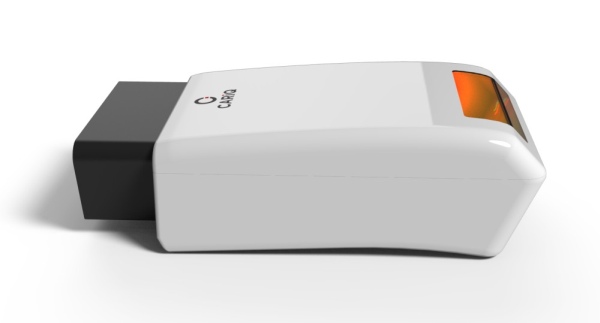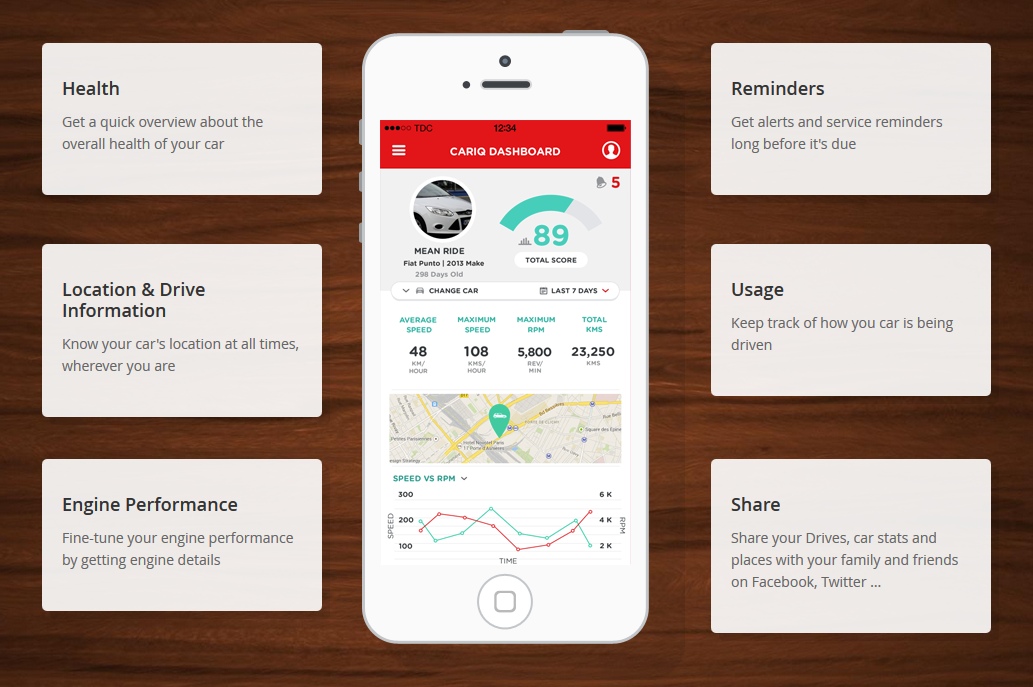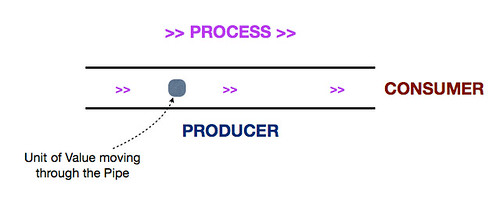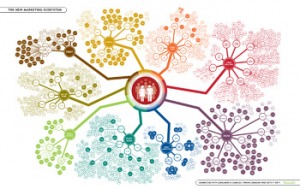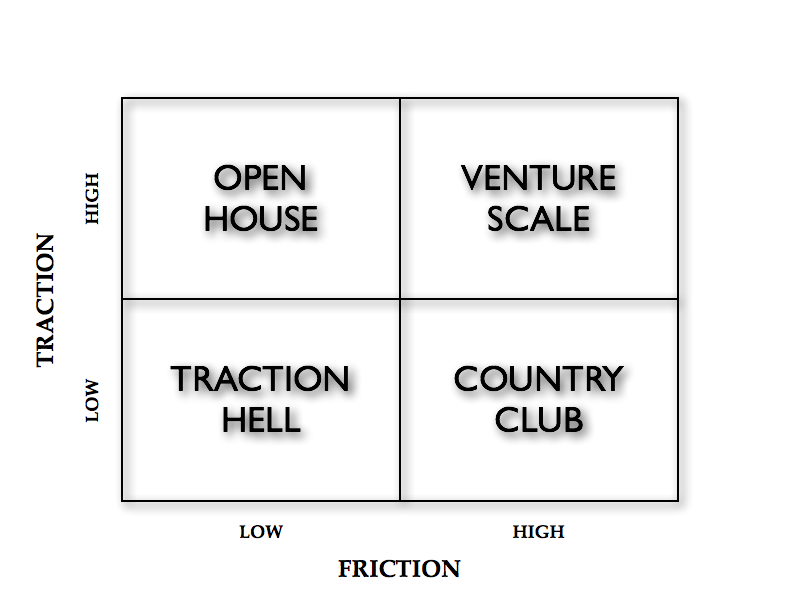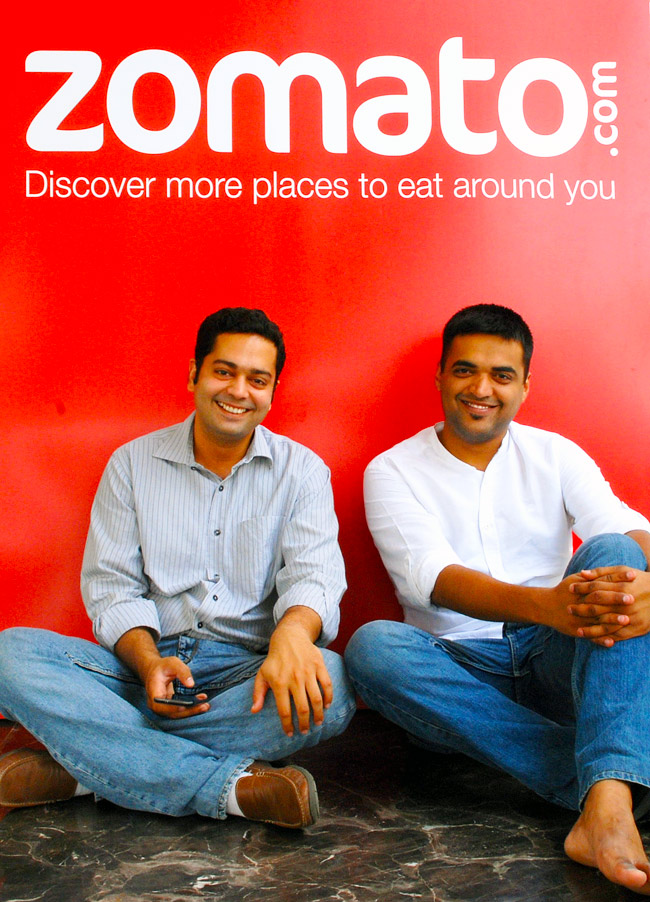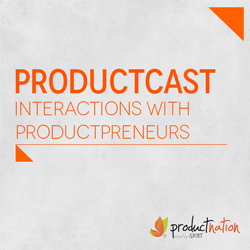Premise: Wealth creation by humans happens in 2 forms, by making “something desirable” or by helping the maker sell it. Everything else is a support function that brings efficiency to these 2 activities. The Web being a communication medium can only help sell something, which happens through some form of lead generation. One might argue that SaaS tools are “desirable” products on the web but the way to see it is that web or the Internet only acts as a distribution medium for the actual product.
There are 3 dimensions or criteria for evaluating a web business.
- How far is it from the “something desirable”?
- How exhaustive or selective the target audience is?
- Is it single power centered or distributed?
1. Distance from Product: Transaction – Information – Network
The representation above will help you visualize the value chain. The transaction layer is the closest to the product and has most control over the chain – in terms of pricing, availability, purchase experience. Though, this is also the most commoditized layer since most factors are internally controllable.
The information layer helps you discover a product and decide about the purchase. The Network layer helps you connect with the information. The outer most layer has little control in terms of purchase but it is the most defensible layer for a web business.
- Value in this chain is created when you push a user inwards from an outer layer. Every change in layer is a lead generated. User moving from one destination to another in the same layer leads to more confusion and is a sign of feature gap.
- Facebook and Google Search* are network layer that generates traffic for information sites, like FindYogi, TripAdvisor etc., which in turn generates leads for transaction layer.
- Most web businesses are generally an overlap of two of these layers. An effective use of these network with information – like Quora or Twitter is powerful. Tripadvisor is probably the best example of marrying the info+network layer. Ecommerce companies are making a decent attempt at marrying transaction with information so that they can influence the value chain better. MakeMyTrip, Cleartrip already enable transactions; with ratings/reviews they are covering the information layer as well. Since there is nothing like review/rating in flight booking, this business is getting commoditized and the players are looking to move to lesser standardized products like selling hotels, holiday packages.
- Sticking to transaction layer only will make you no better than a payment gateway, which has been commoditized. The fulfillment part in the transaction layer is mostly offline. PayZippy from FlipKart and PayUMoney are making small steps to capture the network layer along. PayPal is a great example of transaction+network layer execution.
- The success of each layer depends on what bait you can fetch from the inner layer to entice the user and push her inwards for more. A good basic bait does not generally generate revenue but helps you keep your destination alive. A promoted bait generates revenue for you.
- Any layer is useless by itself. You have to do a lot of seeding from inner layer initially and develop relations with your adjacent layers to grow (through SEO, Affiliates, SMM, Content marketing, Ads). Networks by itself are not useful unless it has information. The information layer by itself is not useful if it does not push you to a transaction and the transaction layer triggers the end fulfillment.
*Google search is essentially driven by what human networks are referring to, the search result page is an organized way of showing the information. An overlap of network with information layer.
2. How exhaustive or selective the target audience is: Bundling – Unbundling
The bundling-unbundling theory has been well highlighted by Benedict Evans through his examples of Craigslist and Linkedin. Most web business are trying to solve the same problems in more efficient ways. The eCommerce, travel, social networking and classifieds industries have existed for long on the web, yet every day we hear of companies trying to disrupt these spaces.
For any new business the easiest way to get a foothold in a saturated market is by unbundling a very specific feature for a very specific audience and doing it better than the large established players. As the market grows and your business matures, you add more features and start bundling everything in your industry. The cycle continues. The unbundling-bundling evolution will never cease.
Unbundling can be done based on geography, user demography, product category or a particular feature. Whatsapp is a great example of unbundling of chat from social network and only for your phonebook contacts. Ixigo started as price comparison for flights, then bundled all forms of travel comparison and is now bundling reviews, all this while focusing on a single geography and single industry of travel decisions.
In eCommerce in India, unbundling has failed big time. Most vertical commerce players haven’t survived. The basic reason for this might be the fact that when unbundling based on product category, a major component of fixed costs remains same. Since the game is about scale, the economics does not work out if you try execute a single category better than the market leader. Have we seen any vertical ecommerce player adding more value than FlipKart/Amazon/Myntra and not survived? Zivame has done a focused execution and seems to be surviving.
The parameter you choose to unbundle on is very important. A lot of times unbundling can only get you noticed, you have bundle up to justify economics and user behavior.
Paytm is taking a bold step of unbundling based on user interface. Paytm’s marketplace is available only on mobile app. We will have to wait to see how it pans out.
Good part of unbundling is that it lets you keep a smaller audience 100% happy and grow there on, rather than keeping a larger audience partially happy. As Paul Graham says, “it’s easier to expand user-wise than satisfaction-wise”. The way to evaluate the scalability of business is to see how easily can more geography, user, target product be bundled up.
Unbundling lets you get deep into a vertical, the way FlipKart did with books. Though, there is an issue of market positioning when you later try to bundle more target products. MakeMyTrip faced this challenge trying to re-position from a flight booking site to a holiday booking site. You could mean different things to different users but one user is going to remember you for just one thing – you have a choice of how broad or narrow you want that to be. TripAdvisor, as a company, is focused on travel decision making but it maintains 17 websites, each solving a different travel need with minor overlap, to avoid any dilution in individual value proposition.
Examples of successful unbundling that might happen in India –
- While some players, like FindYogi, are trying to crack the buying decision problem, Roposo is taking a crack only at the influencing female fashion.
- There is Holidify that is trying to crack only the first step of travel planning – “where to go”.
- Jaypore is taking a crack at only high end fashion ecommerce and doing quite well.
- Zomato was good at unbundling restaurant search from horizontal local search. There is LoyalOye that is unbundling only event venues search.
3. Is it single power centered or distributed – Pipe vs. Platform
This theory is borrowed from Sangeet P. Chaudhary. He professes this theory in detail at his blog, platformed.
A pipe type web business is one in which the atomic unit of value is created by a single source, or the business under-writes the original source. Example – Ecommerce stores, Blogs. This gives you great control over quality and can usually work at all scale.
A platform is when business opens up to let a larger set of audience create value. Example – Marketplaces. This gives you lesser control over quality but is more capital efficient at scale.
The differentiator is more around how the value is created and not how it is consumed. Both Pipe and Platform have their pros/cons.
When you look at scale in a web business, converting from pipe to platform can give you a great leverage in the market. A lot of businesses change their proposition when looking to scale, though a good move from Pipe to Platform is when the end value delivered and the target audience remains unchanged or expands. What you do as a business internally will change tremendously but that should not affect the end product delivered.
- The move by FlipKart from Ecommerce to Marketplace is a good example. Though the company is yet to adopt to a pure play marketplace but the slow transition is making sure the end value is intact. If you look internally the company is now doing less of trading and more of technology.
- At small scale, FakingNews is a good example of converting Pipe to semi-Platform when they launched my.fakingnews.com – a UGC based satire news destination. Same target audience, same value proposition but more value creators. “Semi-platform” because the decision making around what gets published is highly moderated by editor. A full-fledged platform is more like 9gag, where everything gets published but only the best gets surfaced.
You create ‘entrepreneurs’ by distributing powers, that means more rewards in the whole system as a function of higher risk taking capability. Platform also enables decentralization of power/decision making, thereby creating lesser bottlenecks and higher efficiency.


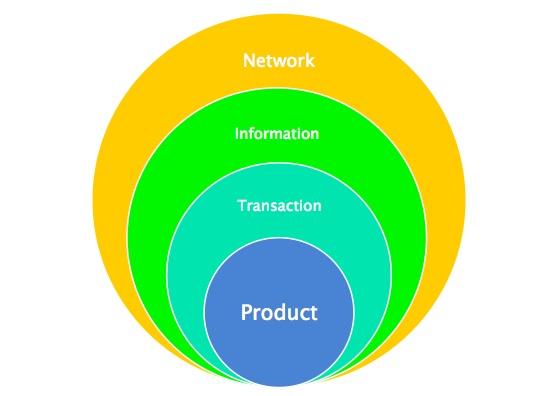
 It was the experience of my purchase of Hyundai i20 a few years ago, which made me aware of an acute problem. When I made the purchase, I knew what car, make, and model I wanted to buy. I knew what mileage to expect, I read reviews, and before I went to the dealer, the decision was already made. There was so much information available to help me buy. But I was not ready for what happened after the purchase. I had to set manual service reminders, I was not aware whether my car was performing as expected. I was apprehensive when I left my new ride parked for hours at open parking places. I just wished, – what if my car was a smart car and managed this for me? Wouldn’t it be cool, if my car could detect problems, remind me of service alerts, or tell me its location even if I was not in the car. That lead me to first investigate mechanical add-on to get this data until I realised that cars have computers, and those computers can talk. I can get data on performance, condition, and even potential unseen problems. That was it. I knew I had to harness this data to convert into meaningful insights.
It was the experience of my purchase of Hyundai i20 a few years ago, which made me aware of an acute problem. When I made the purchase, I knew what car, make, and model I wanted to buy. I knew what mileage to expect, I read reviews, and before I went to the dealer, the decision was already made. There was so much information available to help me buy. But I was not ready for what happened after the purchase. I had to set manual service reminders, I was not aware whether my car was performing as expected. I was apprehensive when I left my new ride parked for hours at open parking places. I just wished, – what if my car was a smart car and managed this for me? Wouldn’t it be cool, if my car could detect problems, remind me of service alerts, or tell me its location even if I was not in the car. That lead me to first investigate mechanical add-on to get this data until I realised that cars have computers, and those computers can talk. I can get data on performance, condition, and even potential unseen problems. That was it. I knew I had to harness this data to convert into meaningful insights.
